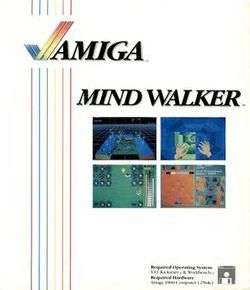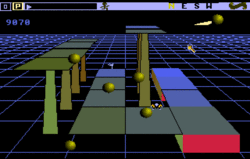Mind Walker
 Cover art | |
| Developer(s) | Bill Williams |
|---|---|
| Publisher(s) | Commodore[1] |
| Designer(s) | Synapse Software[2] |
| Composer(s) | Bill Williams[3] |
| Platform(s) | Amiga |
| Release date(s) | |
| Genre(s) | 3D action platformer[1] |
| Mode(s) | Single-player |
Mind Walker is a 1986 computer game by Bill Williams. The game was published by Commodore and is often cited as the first commercial title for the new Amiga 1000 computer. The game is perhaps best known for its unusual gameplay and concept. It was also chosen by Amiga, Inc. as one of the first six games to be made available to download from their own site using their "Classic Amiga Game Player" to enable users to play the game on a Windows PC.
The player is immersed inside a human brain and must cure a psychosis that is threatening the patient's well-being. Many aspects of the game (including enemies and power-ups) play on this psychological theme. The four player avatars, for instance, are the human bodybuilder, the water nymph, the mysterious wizard, and the alien spriggan.
Gameplay

The first stage of the game requires the player to build a path from a crystal to a special square located somewhere in the brain. Various types of platforms rest between the player's starting point and the destination —each type corresponds to one of the avatars. For example, water can only be connected by the nymph, towers by the wizard, and so on. The destination point is often surrounded by "tubes" which often block the players path as a path cannot be created on a square with a tube. Floating enemies assail the player, who can destroy them with a lightning bolt. However, the player must remain stationary while attacking enemies. The density of enemies increases as the player approaches the destination. Once the destination point is reached the surrounding tubes lower, allowing the player to venture into the next stage. Stages vary depending on which tube is chosen.
The next stage takes place in a 3D first-person perspective (the player is falling down a pit). The player must maneuver so that he falls into one of the green zones and is taken into a deeper region of the brain.
In the next stage, the player must guide the avatar through a maze of neurons that pulse with electricity. Touching any of these neurons while electrified instantly kills the player, and various colored enemies also float around the stage (the damage they incur increases as the game progresses). The player must travel through the maze trying to find a pyramid object (sound can be used as a cue here, it gets faster as the player gets closer). Once the pyramid is obtained the player must backtrack to their starting point, and exit the level (the exit is surrounded with neurons, one must determine the pattern of the electrical pulses and cross while they are inactive).
The last stage, a reference to psychoanalysis, asks players to put together a strange, color-cycling puzzle. At the expense of their accumulated points, players can tap Sigmund Freud's pipe and be shown where a piece must be placed, or they can place the pieces in the puzzle themselves. The puzzle consists 42 spaces (6 x 7), and seven pieces are gained with the completion of each of the six levels.
Reception
Computer Gaming World described Mind Walker as "the most challenging game currently available", describing it as "a bizarre cross of Adept and Marble Madness. The review praised the game's graphics and sound ("It more fully uses the features of the Amiga than any other game"), and concluded "This game is highly recommended as an[sic] very sophisticated arcade type game".[2]
Compatibility
Only one version of Mind Walker was released for the Amiga. Nonetheless, this single version continued to run without problem across four generations of operating system, three generations of CPU, and at least three generations of platform hardware, spanning over six years, starting with the Amiga 1000. Given that the program was written before production hardware was available, this was an astonishing accomplishment, and was easily among the most forward-compatible software products ever released for the Amiga.
References
- 1 2 3 Mindwalker at GameFAQs
- 1 2 Wagner, Roy (November 1986). "Amiga Preferences". Computer Gaming World. No. 32. pp. 38–39. Retrieved 21 May 2016.
- ↑ http://www.angusm.demon.co.uk/AGDB/DBM1/MindW2.html
External links
- "Mind Walker General Info" EAGER Amiga Commercial Game Database. Basic Information with Screen Shot.
- "MindWalker" Game available to buy and download with the "Classic Amiga Game Player" for the PC from Amiga.com
- "MindWalker Documentation" Online Game documentation from the "Classic Amiga Game Player".
- "MindWalker Review" Review and Description of the MindWalker game.